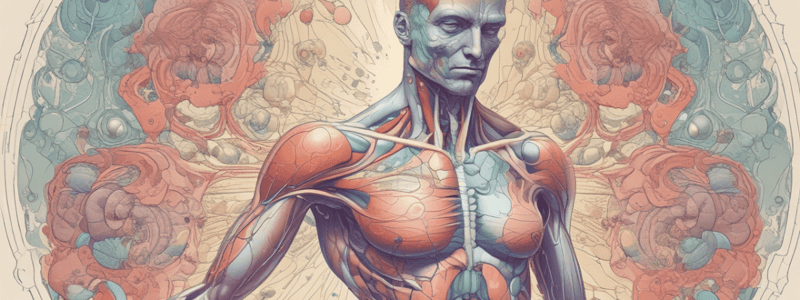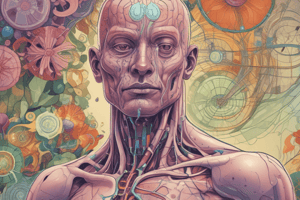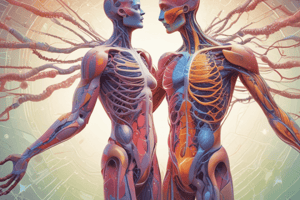Podcast
Questions and Answers
B lymphocytes are the source of ______
B lymphocytes are the source of ______
antibodies
Cell mediated response refers to the direct involvement of ______ to attack an infection
Cell mediated response refers to the direct involvement of ______ to attack an infection
cells
A humoral immune response involves direct contact between ______ and cytokines that bind to receptors on cell surfaces
A humoral immune response involves direct contact between ______ and cytokines that bind to receptors on cell surfaces
cells, molecules
Macrophages encounter and process the antigen and display it on the cell surface with ______
Macrophages encounter and process the antigen and display it on the cell surface with ______
The B cell then becomes a ______ and releases antibodies
The B cell then becomes a ______ and releases antibodies
Apixaban and Rivaroxaban are both highly selective, orally bioavailable, and reversible direct inhibitors of factor ______.
Apixaban and Rivaroxaban are both highly selective, orally bioavailable, and reversible direct inhibitors of factor ______.
Heparin accelerates antithrombin ______ activity 1000 fold.
Heparin accelerates antithrombin ______ activity 1000 fold.
Dipyridamole is a platelet inhibitor that causes ______ and increases blood flow.
Dipyridamole is a platelet inhibitor that causes ______ and increases blood flow.
The most toxic drug side-effect of anticoagulants is ______.
The most toxic drug side-effect of anticoagulants is ______.
Warfarin sodium inhibits ______ K, which serves as a cofactor in the production of clotting factors II, VII, IX, and X.
Warfarin sodium inhibits ______ K, which serves as a cofactor in the production of clotting factors II, VII, IX, and X.
Fibrinolysis is the process where ______ lyses fibrin and degrades factors V and VIII, inhibiting further clotting.
Fibrinolysis is the process where ______ lyses fibrin and degrades factors V and VIII, inhibiting further clotting.
Plasminogen activators include ______ plasminogen activator (t-PA) and urokinase.
Plasminogen activators include ______ plasminogen activator (t-PA) and urokinase.
The clinical use of plasminogen activators includes treatment of ______ myocardial infarction.
The clinical use of plasminogen activators includes treatment of ______ myocardial infarction.
The antifibrinolytic agent ______ competes with plasminogen and plasminogen activators for binding to fibrin.
The antifibrinolytic agent ______ competes with plasminogen and plasminogen activators for binding to fibrin.
Anistreplase is a combination of ______ with an acylated plasminogen, which becomes deacylated in plasma.
Anistreplase is a combination of ______ with an acylated plasminogen, which becomes deacylated in plasma.
Flashcards are hidden until you start studying
Study Notes
Types of White Blood Cells
- Neutrophils: 50-70%, numerous short-lived phagocytes
- Eosinophils: 1-5%, stain red, attack parasites
- Basophils: 0.1%, stain blue, release histamine
- Natural killer (NK) cells
- Mast cells
Phagocytosis
- Associated with Neutrophils, Monocytes, Macrophages
- Enzymes in lysosome digest bacterium, triggering an inflammatory response
- Phagocyte engulfs foreign particles or bacteria
Innate Immunity - Cell Mediated Immunity
- Cytotoxic or Killer Cells (CD8 T cells) are activated by the release of IL-2 from T helper cells
- CD8 cells recognize antigens on the surface of infected cells, attach to these cells, and secrete perforins
- Perforins punch holes into infected cells, killing them
Innate Immunity - TLRs
- Toll-Like Receptors (TLRs) are innate immune sensors
- TLRs trigger a cascade of events to kill or protect against pathogens
- They exist as transmembrane proteins, present on macrophages and a few other cells
- They are conserved across vertebrates, very important part of innate immune system
- They are sensitized to microbes (or their components)
Innate Immunity - Cytokines
- Cytokines are small proteins, secreted by cells of the immune system
- Examples include: Interferons, Interleukins, and Tumor Necrosis Factor (TNF)
- They affect the behavior of other cells, are signalling molecules, and key players in both innate and acquired immunity
- Cytokines are released by many cells of the immune system, including Neutrophils, Macrophages, Cytotoxic/Killer cells, and Lymphocytes
Innate Immunity - Interferon (IFN)
- Signalling proteins produced by virus-infected monocytes and lymphocytes
- Secreted proteins, key anti-viral proteins that inhibit protein synthesis
- Warn neighboring cells that a virus is around, triggering fever, cell death, and increased antibody production
Innate Immunity - Complement
- A large number of distinct plasma proteins that react with one another (C1-C9)
- Complement can bind to microbes and coat the microbes, facilitating phagocytosis and cause lysis of pathogens
- It is an essential part of innate immune response, enhancing the adaptive immune response
Innate Immunity - Inflammation
- A complex biological process by which the body responds to injury
- Macrophages release toxins (including reactive oxygen species or ROS) that injure tissues
- Chronic inflammation is almost always accompanied by tissue damage
Adaptive (Acquired) Immunity
- Immunity that develops after exposure, with the body remembering specific invader
- It relies heavily on the production of antibodies
- Passive or Active, Natural or Artificial
Humoral Immune Response
- An immune response involving direct contact (cells, molecules bind to receptors on cell surfaces) and cytokines
- Involves Antigen Presenting cells (APC), MHC, and the activation of B and T lymphocytes
- Release of cytokines stimulates cells to get activated, multiply, and release antibodies
CO2 Transport and Buffering
- CO2 is directly bound to Hemoglobin (at a site different from the one that binds Oxygen) in the blood.
- The rest of the CO2 is converted into Bi-Carbonate ions and Hydrogen ions (H+) by the Enzyme Carbonic Anhydrase.
- The reaction is reversible, proceeding to the right under conditions of lower temperature, higher pH, and increased oxygen pressure in the capillaries of the lungs.
- Only about 5% of the CO2 generated in the tissues dissolves directly in the plasma.
Bohr Effect and Haldane Effect
- The Bohr Effect: Hemoglobin releases oxygen in response to low pH, high temperature, and low oxygen pressure.
- The Haldane Effect: Hemoglobin releases CO2 in response to high pH, low temperature, and high oxygen pressure.
The Cardiovascular System and CO2
- CO2 is an acid, and its accumulation can lead to a drop in blood pH.
- The equation CO2 + H2O ↔ H2CO3 ↔ H+ + HCO3− shows the conversion of CO2 into H+ and HCO3−.
Blood Clotting and Hemostasis
- Blood clotting has several positive feedback loops that amplify the clotting process.
- The TF-VII complex starts the clotting process, which activates Factor IX and X, leading to the formation of thrombin.
- Thrombin activates more Factors V, VIII, and XI, and also converts fibrinogen to fibrin.
- Platelets release thromboxane A2, which recruits and activates more platelets, and serotonin, which enhances their clumping and promotes blood vessel constriction.
Anticoagulants and Thrombocytopathics
- Direct-acting anticoagulants: Apixaban (Eliquis) and Rivaroxaban (Xarelto) are highly selective, orally bioavailable, and reversible direct inhibitors of factor X.
- Heparin: accelerates antithrombin III activity, which inactivates factors IX, X, and XI, and thrombin, preventing fibrin formation.
- Indirect-acting anticoagulants: Dicumarol or Warfarin sodium inhibits Vitamin K, which is necessary for the production of clotting factors II, VII, IX, and X.
- Platelet inhibitors (Thrombocytopathics): Aspirin inhibits thromboxane synthesis, resulting in decreased platelet aggregation, and dipyridamole causes vasodilation and increases blood flow, while inhibiting phosphodiesterase, resulting in reduced platelet aggregation.
Erythrocytes (RBCs)
- Males have approximately 5.4 million Erythrocytes per cubic millimeter of blood (range: 4.6 - 6.2 million), while females have about 4.8 million (range: 4.2 - 5.4 million).
- Males have approximately 10% more Erythrocytes than females.
- Normal Erythrocytes are biconcave disks about 7.5 micrometers in diameter with thicker edges than the center of the cell.
- The biconcave shape increases the surface area of the erythrocyte, making the movement of gases (oxygen and carbon dioxide) into and out of the cell more rapid.
- The erythrocyte can bend or fold around its thin center, decreasing its size and enabling it to pass more easily through small blood vessels.
RBC Factoids
- Women average about 4.8 million RBCs per cubic millimeter (mm3) of blood, while men average about 5.4 x 10^6 per µl.
- These values can vary depending on factors such as health and altitude.
- Peruvians living at 18,000 feet may have as many as 8.3 x 10^6 RBCs per µl.
RBC Development and Function
- RBC precursors mature in the bone marrow closely attached to a macrophage.
- They manufacture hemoglobin until it accounts for about 90% of the dry weight of the cell.
- The nucleus is squeezed out of the cell and is ingested by the macrophage.
- No longer needed proteins are expelled from the cell in vesicles called exosomes.
- RBCs are terminally differentiated, meaning they can never divide.
- They live about 120 days and then are ingested by phagocytic cells in the liver and spleen.
- Most of the iron in their hemoglobin is reclaimed for reuse.
Carbon Dioxide Transport
- About one-half of the CO2 is directly bound to hemoglobin (at a site different from the one that binds oxygen).
- The rest is converted into bicarbonate ions and hydrogen ions by the enzyme carbonic anhydrase.
- Bicarbonate ions diffuse back out into the plasma, while hydrogen ions bind to the protein portion of the hemoglobin.
Hemoglobin and Oxygen
- Under the conditions of lower temperature, higher pH, and increased oxygen pressure in the capillaries of the lungs, the reaction proceeds to the right, and deoxygenated hemoglobin becomes oxyhemoglobin.
- Under the conditions of higher temperature, lower pH, and lower oxygen pressure in the tissues, the reverse reaction is promoted, and oxyhemoglobin gives up its oxygen.
The Cardiovascular System
- The cardiovascular system distributes nutrients, oxygen, and hormones to all cells in the body and carries away metabolic waste products.
- The system consists of the heart, blood, arteries, arterioles, venules, and capillaries.
Blood
- Blood is composed of plasma and formed elements.
- Plasma makes up about 55% of the total blood volume and is composed of 92% water, electrolytes, and proteins.
- Formed elements include blood cells and platelets.
- Blood cells are divided into red blood cells (RBCs), which make up about 99.9% of all blood cells, and white blood cells (WBCs), which make up about 0.1% of all blood cells.
- RBCs have no nucleus and are biconcave in shape, with 95% of their composition made up of hemoglobin (Hb).
- Hb can reversibly bind 4O2 and 4CO2.
Platelets
- Platelets have no nucleus and are involved in blood clotting.
- They engulf and destroy pathogens, induce inflammation, and fight parasitic infections.
- Platelets produce antibodies and provide immunity.
Blood Clotting
- Hemostasis is the process of stopping bleeding, which involves platelet activation, clotting, and fibrinolysis.
- Platelets adhere to collagen in the damaged blood vessel wall, releasing thromboxane A2, which recruits and activates more platelets.
- The clotting process involves a series of coagulation factors, including thrombin, factor VII, and factor IX.
- Fibrinolysis is the process of breaking down the clot, which involves the conversion of plasminogen to plasmin by plasminogen activators.
Fibrinolysis
- Plasmin is generated from the enzymatic conversion of plasminogen.
- Plasmin lyses fibrin, degrades factors V and VIII, and inhibits further clotting.
- Plasminogen activators, such as tissue-type plasminogen activator (t-PA) and urokinase, convert plasminogen to plasmin.
- Antifibrinolytics, such as e-aminocaproic acid (EACA) and alpha2-antiplasmin, can be used to limit fibrinolytic activity.
Studying That Suits You
Use AI to generate personalized quizzes and flashcards to suit your learning preferences.




